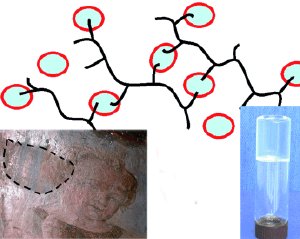Oct 26 2009
In the past, restoration of paintings and other old artwork often involved application of acrylic resins to consolidate and protect them. One of the most important tasks for modern restorers is thus to remove these layers, because it turns out that acrylic resins not only drastically change the optics of the treated artwork, but in many cases they accelerate their degradation. Italian researchers working with Piero Baglioni at the University of Florence have now developed a technique to effectively remove such old polymer layers from sensitive historic artworks. As the researchers report in the journal Angewandte Chemie, the new cleaning system involves only a tiny proportion of volatile organic compounds. "We have demonstrated the first successful application of a water-based system for the removal of an organic layer from artwork," says Baglioni. "In addition, our method is simpler and less invasive than traditional processes."
 © Wiley-VCH
© Wiley-VCH
The scientists use an oil-in-water microemulsion with the organic solvent para-xylene as the oil component. An emulsion is a fine dispersion of droplets of one liquid in another liquid with which the first is not miscible. One example from our daily lives is milk. A microemulsion is an emulsion that forms spontaneously and is stable. It contains substances that act as emulsifiers. Because the individual drops are only nanometer-sized, the mircoemulsion is not milky and opaque, but clear and transparent.
The Italian researchers embedded their micoremulsion in a matrix of a modified type of cellulose—a material used as a thickener for emulsion paints. The matrix makes the cleaning agent viscous, so that it cannot enter very far into the pores of a painting. Its activity is limited to the outer layer, whilst deeper layers of paint do not come into contact with the xylene. The environment is protected as well, because of the very low concentration of volatile solvent, the evaporation of which is further limited by the matrix. The optical transparency of the system also allows the restorer to continuously monitor the cleaning process.
"We successfully cleaned a mural from the 15th century," reports Baglioni. This painting is located in the Santa Maria della Scala Sacristy in Siena. "It was covered with a 35 year old layer of acrylic from a previous restoration. Our new system allowed us to completely remove the undesirable shine. We were also able to clean another art work: a gilt frame from an 18th century painting."